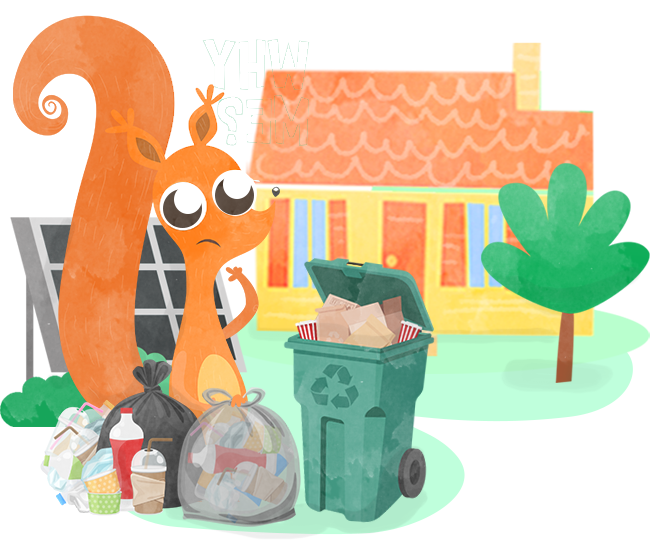
Do you aspire to live green but don’t feel like you have the money in your budget?
Have you checked the price of sustainably harvested cotton apparel and felt nauseated?
Do you shamefully avoid the “organic and local foods” section while grocery shopping because paying $7 for a quart of blueberries would destroy some small part of you?
We get it — and we have some good news: it’s perfectly possible to reduce one’s personal carbon footprint without blowing past your budget. You could even be saving money while you do it.
If you’re looking for tips on how to reduce your carbon footprint and your monthly expenditures, you’ve come to the right place.
If you’re really feeling broke, don’t worry. There are ways you can reduce your carbon footprint that don’t actually cost you any additional money up front.
Vintage or recycled clothing is not only much less expensive (usually) than buying new garments, but infinitely more sustainable from an environmental impact perspective. Most of the time you won’t even have to sacrifice quality or style to shop used clothing either.
If you’re willing to sort through some of the most hideous garments known to humankind, you can find some absolute gems at most thrift stores, especially if you live in a college town.
What’s more, clothing isn’t the only thing you can buy used to save money and reduce your carbon footprint without sacrificing on quality. Furniture, cookware, dishes, and appliances are all excellent opportunities to get something that’s basically just as good as it would be new for a whole lot less money and a much smaller carbon footprint.
One caveat here is that older appliances sometimes are much less energy efficient than new ones. Buying a used refrigerator from the 1990s is actually less carbon friendly than buying a brand new one in the long run because the new refrigerator will use less than a quarter of the energy to run.
That old refrigerator will also cost you more money over time, too. Our hypothetical 1990s fridge is likely to use about 1,700 kilowatts per year to run, compared to the 450 necessary for a newer, energy star rated fridge. At an average cost of 17.5 cents per kWh in the US, that’s a savings of nearly $220 per year.
Don’t worry though: you can get used, energy star appliances quite a bit cheaper than buying them new. I was able to find a used energy efficient refrigerator in excellent condition at about half the price you could expect to pay for it new, and that’s shopping from a used appliance retailer — you’re likely to be able to get even better deals buying from individual sellers on Facebook marketplace or Craigslist if you’re willing to do a little extra leg work.

You don’t have to be an molecular biologist to understand that plastic bottles are about as good for the environment as cigarettes are for your lungs (just Google “great Pacific garbage patch” — but only if you want to get depressed about the future of our planet).
On the other hand, since a bottle of water tends to cost less than a dollar at the grocery store, it may seem like the more economical option when compared to paying $40 for a meme-worthy reusable bottle.
If you’re like me and would lose your head if it weren’t attached to your body, perhaps buying an expensive water bottle isn’t the best choice for you financially. But here’s the thing: you don’t have to spend $40 on a water bottle. In fact, you can get a decent, BPA-free, reusable water bottle from a popular internet retailer for $10.
Let’s do some quick math. The National Academy of Sciences recommends drinking 120 ounces of water per day, or 43,800 ounces per year. (If you’re not doing this, there’s about a thousand reasons you should be that I don’t have time to get into here, but seriously — drink more water.)
Anyways, the absolute cheapest I could find bottled water on the internet was $3.50 for a pack of 24 seventeen-ounce bottles — that’s 408 ounces per pack. To meet your daily required water intake drinking only this bottled water, you’d have to buy 107 packs. That’s $374.50 per year on bottled water, and you’ve used 2,568 bottles.
By comparison, you could buy even a Tik-Tok-famous, brand-name water bottle; the best faucet-mounted water filter known to humanity; and 2 replacement filter packs for about $100. That’s enough filtration for over 50,000 gallons of water — and you could afford to lose 8 of those fancy water bottles before you spent as much as you would on a year’s worth of disposable bottles.
Plus, if you manage to hang on to the dang thing, a reusable water bottle will last you literally forever, which means your ongoing yearly water expenditures are going to be about $44, since all you have to buy are replacement filters for your faucet.
The TLDR here is that, if you care about your bank account and/or the environment, you shouldn’t be drinking bottled water. Invest in a good, reusable bottle (put one of those GPS trackers on it if you don’t trust yourself not to lose it).
Despite the fact that every tag on every article of clothing I can ever remember looking at says “machine wash, cold” on it, the conventional wisdom is that doing laundry with warm water is the best way to make sure it gets as clean as possible.
There is something to this — warm water dissolves stains and dirt better than cold water does. (Anyone who’s ever tried to mix actual granulated sugar into an iced coffee and ultimately just gave up and dumped the thing out knows exactly what I’m talking about.)
Here’s the thing, though: laundry detergent has come a loooooong way in the past few decades. At this point, unless you have some seriously set-in stains (that, let’s be honest, aren’t going to come out anyways), you can go ahead and follow the instructions on your clothes’ tags.
Not only will washing your clothes in cold water help improve their longevity (hot water opens fibers more, which causes colors to fade more quickly), it’ll use less energy and you’ll save money to boot.
Here’s a secret you may not be aware of: the vast majority of the energy used when washing a load of laundry comes from the need to heat the water. So, if you wash your clothes in cold water, you reduce your energy usage something like 90%.
Depending on how much laundry you’re doing, this could save you anywhere from $15 to over $200 per year on energy costs (which, of course, means you’re reducing your carbon footprint as well).
If you have the space, time, and patience, ditching your dryer is another excellent way to reduce your overall energy usage, thus saving you money and reducing your strain on the environment.
If you assume an average dryer with average usage, you’re looking at a yearly energy usage of about 850 kWh, which will cost you in the ballpark of $140.
One other benefit to hang-drying your clothing is that it’s much better for your clothes. Dryers wear away at clothes pretty heavily — what do you think all that dryer lint you pull of the screen is made of? So, if you make the effort to hang your clothes to dry, you’ll also end up spending less money on clothes overall, since they’ll last longer.

This one’s kind of a no-brainer, but, in case you hadn’t heard, driving a car does more than just damage the environment — it costs you money. When thinking about how much a trip to the grocery store costs you, it goes beyond the price of the gas in your car.
In fact, the US Department of Energy estimates that the average American driver pays about $0.58 for each mile they drive.
That figure on its own isn’t anything that’s going to send folks running for their metro cards or anything, but it does add up. The average American drives around 14,000 miles per year (according to the Federal Highway Administration), which — if you’re driving a vehicle you own — is going to cost you a little over $7,000.
You’ll also be responsible for adding approximately 4.2 metric tons of CO2 to the atmosphere each, which is about as much as the weight of two full-grown rhinoceroses (or a little more than half a killer whale).
Depending on where you live, walking may or may not be a feasible option for you in terms of saving money and reducing your carbon footprint. If you live somewhere relatively walkable, however, you could save yourself a decent amount of money (and rhinoceroses) by walking places that are closer to your home.

The decisions you make while you’re behind the wheel also have a lot to do with how much it costs (in terms of both cash and carbon impact) to drive. Here are a few easy tips that will save you money and guilt over time if you employ them consistently.
Sure, we all want to be the star of our own personal Fast and Furious movie, but let’s face it: peeling out of a red light stop isn’t going to make you The Rock. It will, however, use a heck of a lot more gas and wear your car out much more quickly than if you accelerated more like you were going for a casual Sunday afternoon drive around a lake than you were being chased by a gang of vindictive mobsters.
According to the US Department of Energy (USDE), accelerating and braking slowly can improve the fuel economy of your vehicle by between 10 and 40% (depending on the car you’re driving and whether you’re on the highway or in stop-and-go traffic) — and that’s not even accounting for the reduction in wear and tear placed on your vehicle.
All of this is not only going to help you save money, but also reduce the greenhouse gas emissions created by driving, and further reduce your carbon footprint by extending the life of various parts of your car (especially your tires and brakes).
Sorry speed demons, but driving fast also costs quite a lot more in both fuel economy and wear and tear on your vehicle. The AFDC estimates that for every 5 mph you drive over 50 mph, your basically paid between $0.24 and $0.48 extra per gallon in gas.
The USDE made a fun, little calculator where you can see exactly how much your driving habits cost you. I tried it out and the results were pretty impressive: by slowing from an average highway driving speed of 75 mph to 60 mph, I could be saving nearly $1.50 per gallon on gas.

Keeping tires properly inflated can improve the fuel economy of your vehicle by up to 3% (the average improvement is 0.6%). This figure depends on the vehicle you’re driving and on how underinflated your tires are. The USDE estimate is that for every 1 psi below optimal inflation, you lose about 0.2% in fuel economy. This does not seem like that impressive of a number, but it does add up.
Even if your tire is only 5 psi flat (which you would never notice without a sensor telling you to inflate the tire), that’s like driving an extra 115 miles per year — not great for your wallet or your carbon footprint.
Sure, you never know when you’re going to need those golf clubs, but maybe consider keeping them in the garage instead of your trunk. As you might expect, the more weight your car has to drag around, the harder it has to work to do it. The USDE estimates that for every extra 100 lbs in your vehicle, you lose about 1% of your fuel economy.
So, by reducing the overall carrying load of your car, you can save money at the pump and reduce the greenhouse gas emissions created by your car when you drive.
Incandescent light bulbs were invented in the late 1800s and haven’t been improved all that much since then. They still generate light by heating up a piece of tungsten until it glows enough to emit light. This means that the vast majority (90%) of the energy consumed by your incandescent light bulbs goes into heat production — i.e. it’s wasted.
LED bulbs just absolutely destroy their incandescent grandparents in an energy efficiency contest: not only do they use a quarter of the energy overall, but none of that energy goes into heat production. Plus, they last basically forever.
The real icing on this energy and carbon savings cake is that LED bulbs are, as of this writing, officially cheaper than incandescent light bulbs. A pack of 24 non-dimmable, soft-white LED bulbs will run you around $30, whereas you’re going to shell out $20 or so for 12 incandescents.
Ultimately, replacing all of the incandescent bulbs in your home with LEDs will reduce your home energy consumption fairly significantly, which is good for your savings account and your carbon footprint.

I’d say “raise your hand if you relate to this tweet,” but the collective force of billions of hands all rising at the same time would probably cause some sort of devastating tsunami and Miami might be lost forever.
The point is, we tend to buy quite a lot more food than we actually end up eating; in the United States, food waste is basically a national pastime.
According to Feeding America (a Chicago-based nonprofit working to eliminate food insecurity in the US), nearly 40% of the food created in the US is ultimately thrown away, unused.
If that statistic doesn’t absolutely rock your world, think about it this way: according to the US Bureau of Labor Statistics, the average household spends approximately $610 at the grocery store each month; at this rate, households are throwing away $243 on a monthly basis.
Food waste of this quantity has a devastating impact on more than just your bank account: according to the University of Michigan Center for Sustainable Systems, “food accounts for anywhere from 10–30% of a household’s carbon footprint.”
That means, depending on what types of food you’re eating, you could be piling on the greenhouse gas emissions for no reason whatsoever.
If you can shop smarter and only buy products that you know you’ll use, you’ll not only save a considerable amount of money each month, but reduce your carbon footprint significantly as well.
Bringing your own bags to the grocery store isn’t going to turn you into a millionaire overnight or anything, but it will save money over time. More and more grocery stores are ditching plastic bags and offering only paper bags, which cost you 5¢ each.
Even over the course of a year’s worth of grocery shopping, bringing reusable bags may only save you in the ballpark of $10, but it does reduce carbon emissions associated with your shopping trip.
Just one of those paper bags you buy at the grocery store emits approximately 12 lbs of carbon dioxide during production, which is equivalent to driving your car about 18 miles.
If you do the math on that over a course of a year’s worth of grocery trips (estimating about 4 trips per month and 3 bags used per trip) you’re producing 1,746 lbs of carbon dioxide per year, the equivalent of driving 261 miles.
Most large urban centers have buy nothing groups associated with them. These groups, which exist primarily on Facebook and other social media sites, offer members a way of lowering their carbon footprints by trying to reduce the overall amount of stuff that they have to buy new.
So, members will post about anything they have available that they no longer need, and other folks on the group who have a need will come and get it. (And when I say “anything they have available” I mean anything. I noticed all of the following available on a quick scroll through my local group: assorted laptop chargers, a can opener, some of those ice packs that come with home meal kit delivery services, and a suitcase.)
Buy nothing groups are a nice way to engage with your local community and also reduce the need to consume newly-produced goods. They also save you money, since everything posted in buy nothing groups is free!
If you really want to lower your contributions climate change and don’t mind spending a little on the front end if it will save money (and the environment) in the long run, here are some suggestions for ways to take a bigger chunk out of your carbon footprint.
We already briefly discussed the difference in energy costs between an antiquated refrigerator and a newer, energy efficient model. The savings you can accumulate if you’re willing to spend money on other energy efficient appliances is significant as well.
Depending on the appliance, energy star appliances will use between 10 and 50% less energy than their less conscious cousins. Over the life of the appliance, this kind of savings will definitely pay for itself.
Life has changed since the pandemic, and many households have been going out less, either to avoid contact with other people or because jobs that used to require going to an office have become remote. If, like many, you aren’t driving as much as you used to, it may be feasible to transition to being a one-car household.
Owning a car is expensive; owning two, twice as much. Not only will you be able to make some money on the front end from selling a vehicle you don’t really use anymore, but, according to AAA, the average American would save upwards of $10,000 per year on reduced fuel, maintenance, insurance, and registration costs by ditching one of their cars.
If you think an extra $10,000 per year would make your life easier, remember what it will do for your carbon footprint: that’s two rhinoceroses worth of carbon dioxide you aren’t releasing into the atmosphere anymore.

If you look at the top 10 most carbon-intensive food sources, the first 8 are all animal products. Lamb, beef, cheese, pork, and turkey are especially bad, all requiring more than 10kg of CO2 to produce a single kg of the product itself.
A vegan diet, on the other hand, has much smaller carbon footprint: a kg of nuts, tofu, vegetables, and lentils all require less than 3 kg of CO2 to make. The difference in carbon emissions between a plant-based diet and one with lots of animal products is monumental. In fact, an Oxford University study estimated that eliminating animal products from your diet could reduce your carbon footprint by up to 73%.
The average person in the United States has an annual carbon footprint of about 16 tons. So, if you’re a standard US resident, becoming a vegan has the potential to reduce your carbon footprint by 12 tons per year — the weight of two full-grown killer whales.
Going vegan will also significantly lower the cost of your grocery bill. A quick search of my local grocery store’s offerings turned up the following information:
Just from this quick check, it’s fairly clear that not buying animal products has the potential to save quite a lot of money in a year. This is corroborated by a study published in the Journal of Hunger & Environmental Nutrition, which found that eating a vegan diet was $746.46 cheaper per year than eating a traditional American diet.
Not only does an Amazon Prime membership cost you $140 per year, but it’s likely causing you to adopt spending habits that are simultaneous unnecessary and excessive. The ability to order basically anything you want and have it arrive at your doorstep in 2 days’ time is unbelievably convenient, for sure; however, it’s also wasteful in more ways than one.
Between the ease with which you can purchase products on the app or website, the pressure to make purchases so as not to “waste” the money you are spending on the membership, and the thrill of having packages delivered to your door a mere 48 hours after clicking “buy now,” it’s well documented how an Amazon membership changes your behavior as a consumer.
People with Amazon memberships may feel like they’re getting more bang for their buck, but they are also spending quite a lot more money than those without those memberships. According to a survey conducted in 2021, folks with Amazon Prime memberships spent on average $1,400 per year on the site, whereas those without memberships spent less than half of that, a mere $600 per year.
So, by cancelling your Amazon Prime membership, you could realistically be saving quite a lot more than the $140 you’re spending on the membership itself. What’s more, you know what all those delivery vehicles running around means for the company’s carbon footprint.
Despite the fact that Amazon allegedly ordered 100,000 custom electric vehicles for its delivery fleets from Rivian in 2019, the company reported producing a whopping 71.51 million metric tons of CO2 in 2021. That’s the weight of 360,000 blue whales (18 times the actual world population of the species) in a single year.
Will you cancelling your membership make a dent in that number? Absolutely not. But, if you do the math, you’re saving about 715 lbs of CO2 per year by cancelling.

Totally cutting flying out of your life might not be entirely possible for everyone. Despite that, reducing the amount of flights you take will have a serious impact on your carbon footprint. There’s not a whole lot worse you can do for the environment than getting on a plane other than perhaps dumping oil directly into the ocean.
On a per-gallon basis, burning jet fuel releases ridiculously more greenhouse gasses than gasoline. For example: a drive from New York to Atlanta would use approximately 29 gallons of gas, releasing 578-ish lbs of CO2, a flight between those cities will put nearly 15,000 lbs of greenhouse gasses into the atmosphere.
If you’re trying to save money and reduce your carbon footprint, avoid flying whenever possible. If you can drive there in a few hours or less, you won’t even be spending all that much more time than you would at the airport, and your wallet and the environment will thank you (especially if you drive a hybrid or electric vehicle).
If you have means to put some money down in order to reduce your carbon footprint and are okay waiting for the investment to pay off, there are a few things you can do to seriously reduce the amount of greenhouse gasses you put into the atmosphere and save money in the long run.
The upfront cost of solar panels is rather high (you’re looking at anywhere from $10,000 to upwards of $40,000 depending on where you live and the size of your home), however, in all but the most sun-starved of locations, they’re basically guaranteed to save you more money than you spend in their lifetime — it might take 10+ years though, depending on how much sun your specific roof gets.
Project Sunroof, which is powered by Google Maps, offers a free, online tool that estimates the savings you can expect from installing solar panels on your roof. Even in Rochester, NY (which enjoys a whopping 61 days of sunshine per year), installing a solar panel is estimated to save $6,000 on energy costs over the 20 year expected life of the solar panels.
If you live in a city that enjoys a bit more sunshine than we do in the bleak Northeast, like Phoenix, AZ, for example, your savings can skyrocket to over $10,000 over the life of your solar equipment.
The environmental savings represented by solar panels is also significant. If I were to install solar panels on my roof (the one in Rochester), the reduction in greenhouse gas emissions would exceed 5 metric tons per year, equivalent to taking 1.2 passenger cars off the road or planting 92 new trees.
The best part about choosing to make the investment in a home solar system is that you can get the government to cover a significant portion of the cost in the form of tax incentives and rebates. The US Government currently offers a tax incentive for installing a solar system which will pay for 30% of the upfront cost. Many states have similar incentives as well.

According to energy.gov, energy loss or gain due to outdated windows can account for between 15 and 30% of a household’s energy use. If you live in a region of the world where temperatures get extreme, this is going to punish you severely in the warmest and coldest months of the year.
Replacing windows and doors can get expensive, especially if you’re doing it all at once. However, there are some programs that will help subsidize the costs, especially if you’re making below a certain yearly income.
Windows and doors aren’t the only places where homes’ energ

y inefficiencies shine. If you live in an older house especially, it’s likely that there are cracks and gaps all around where your warm air escapes in the wintertime.
In most US cities, you can get a free home energy audit that will identify places where your home would benefit from some sealing. The sealing itself won’t be free — in fact, it’s likely to cost anywhere between $5,000 and $15,000 depending on the size and condition of your home. Don’t worry though: there are government-sponsored energy efficiency grants that can help with the cost of sealing your home.
What’s more, the EPA estimates that a properly-sealed home will save its owner between 11% and 15% on heating and cooling costs. So, even if you do end up having to shell out some serious dough to get the sealing done, you will absolutely recoup those costs in the long run in the form of much lower heating and cooling bills.

You have to be a special sort of person to be able to feed yourself and your family purely on subsistence farming, however if you have the space and a little bit of time, you could be growing enough vegetables in your home to offset at least some of the cost of going to the grocery store each week.
Leafy greens, herbs, and even some fruits like tomatoes or cucumbers can all be grown indoors with relatively little investment or effort. If you have access to some outdoor space, the possibilities increase exponentially.
There are innumerable online guides to home-gardening that will provide advice on how much to plant, which plants to choose, and when to grow what. What is clear from perusing some of these guides is that it is perfectly reasonable for a single person to supply themselves (or even a small family) with all the vegetables they need throughout the growing season given a couple hundred square feet of outdoor space.
If you really want to dig into subsistence farming, getting a couple of chickens (assuming it’s legal to do so in your municipality) will provide all the eggs a small family could possibly eat.
If you’re truly able to offset your grocery trips with produce you’ve grown at home, you’ll not only save money and reduce the number of grocery trips you need to make in a month, but you’ll be making a significant reduction to your carbon footprint as well.

If you’re really committed to reducing your environmental impact (and perhaps even saving some money in the long run), you might consider relocating entirely. Certain areas require a person to have a much larger carbon footprint than others — consider that a home in Toronto is going to require much more energy to stay warm than a home in Phoenix. Likewise, a home in Seattle will have much lower air conditioning requirements than a home in San Diego.
Another consideration to make other than just the climate where you live is the infrastructure of the city itself: where does it get the majority of its power? How walkable is it? Do the laws promote green living?
If you live in a city with high energy costs and low walkability, your carbon footprint is going to be much larger than someone who lives in an area where energy costs are low and cars are a luxury, not a necessity.
ParkSleepFly recently conducted a study which attempted to order the 50 most visited cities in the US in terms of their overall sustainability. Portland, OR; Seattle, WA; and New York, NY ranked at the top of the list as the most sustainable cities. On the other hand, Nashville, TN; Columbus, OH; and Houston/Dallas, TX were the least sustainable.
Granted, this study was primarily aimed at the environmental impact of traveling, it did incorporate public transportation use, source of energy, and overall carbon footprint per capita.
If you are thinking of moving somewhere where you’ll be able to live a more environmentally friendly lifestyle without breaking the bank, you should probably do a bit more research before you pull the trigger.
YOUR FREE FINANCIAL PLAN
Are you ready to invest in your future?
Build your free plan today.
Start now